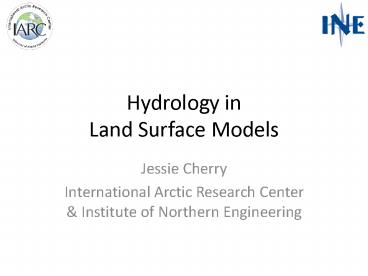Hydrology in Land Surface Models PowerPoint PPT Presentation
1 / 16
Title: Hydrology in Land Surface Models
1
Hydrology in Land Surface Models
- Jessie Cherry
- International Arctic Research Center Institute
of Northern Engineering
2
Many LSMs classify vegetation by biomes
3
Community Land Model
- LSM for CCSM, CLM at version 3.5 (4.0 has been
under development for 5 yrs) - The model formalizes and quantifies concepts of
ecological climatology - Model components consist of biogeophysics,
hydrologic cycle, biogeochemistry and dynamic
vegetation - 5 primary sub-grid land cover types (glacier,
lake, wetland, urban, vegetated) - The vegetated portion of a grid cell is further
divided into patches of plant functional types,
each with its own leaf and stem area index and
canopy height - Each subgrid land cover type and PFT patch is a
separate column for energy and water calculations - T42 2.5 deg x 2.5 deg
4
CLM Model Methodology
- The model is designed to run in three different
configurations - 1. Stand-alone executable code as part of the
Community Climate System Model (CCSM). - 2. A subroutine call within the Community
Atmosphere Model (CAM) in which CAM/CLM represent
single executable code. - 3. Stand-alone executable code in which the model
is forced with atmospheric datasets. In this
mode, the model runs on a spatial grid that can
range from one point to global.
5
Coupling Strategies
6
Biogeophysics
7
Hydrology and River Routing
- Includes interception of water by plant foliage
and wood, throughfall and stemflow, infiltration,
runoff, soil water, and snow - Directly linked to the biogeophysics and also
affect temperature, precipitation, and runoff - Total runoff (surface and sub-surface drainage)
are routed downstream to oceans using a river
routing model only for the largest river systems
8
River Routing
9
Major Systems
10
LSM Water Balance
11
Separate River Transport Model
- A river transport model (RTM) (Branstetter et
al., in prep) is synchronously coupled to the
Community Land Model (CLM) for hydrological
applications as well as for improved
land-ocean-sea ice-atmosphere coupling in the
Community Climate System Model (CCSM) - This model was implemented on a 1/2 degree grid.
Code internal to the land model interpolates the
total runoff from the column hydrology (e.g.,
T42, T31 grid) to the river routing 1/2 degree
grid
12
(No Transcript)
13
Dynamic Vegetation
14
Model Component Dynamic Vegetation
- Ecosystem Carbon Balance the carbon cycle but
also changes in community composition and
vegetation structure in response to disturbance
(e.g., fire, land use) and climate change - There are two time-scales for this dynamics
Succession considers changes in community
composition and vegetation structure over periods
up to several hundred years, typically following
disturbance such as fire or land use. Over
longer-periods of times (e.g., centuries,
millennia) the biogeography of vegetation changes
in response to climate change.
15
Succession/Change in Biogeography
16
(No Transcript)

